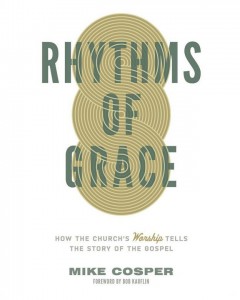Rhythms of Grace: How The Church’s Worship Tells the Story of the Gospel
by Mike Cosper

Genre: Christian ministry / worship
Size: 223 pages. Just 10 chapters and 3 Appendices. I read through the whole thing in 2 days, and again more slowly over the course of several weeks.
What’s the big idea: The gospel is all about worship – once broken by sin – restored in Jesus. Worship, whether scattered or gathered, is all about rehearsing the gospel story, and being shaped by it.
Amazingly Mike starts not by defining worship. Instead, for the first 4 chapters he walks the reader through how the Bible describes worship – from Eden, the wilderness, in Israel, and then in Jesus (biblical theology).
Chapter 5 is the clincher where Mike unpacks the “Worship 1-2-3” paradigm he uses to summarise what worship means for the local church (first described in this interview). Basically, worship has one object (the Triune God), two contexts (gathered and scattered), and three audiences (God himself, the gathered church, and the watching world). With this paradigm, Mike shows how many of our disagreements about worship comes from overemphasising one of these aspects. For example:
You’ll find that many of the heated battles of the worship wars erupt when these categories get confused. For instance, the well-intentioned seeker-sensitive movement seems to have lost sight of the church as an audience in worship (and a crucial one). Those who would rather lie in bed and watch The Masters on Sunday have lost sight of the call to gather with God’s church. Those who compartmentalize their “church” life from their hellish “secular” life forget that they are living sacrifices, and all of life is an act of worship. (p.86)
Chapters 6-8 focuses more on defining and fleshing out gathered worship as spiritual formation, as historically rooted in the story of the church, as an opportunity to rehearse the gospel story (he terms it “rhythms of grace”, hence the title). Chapters 9-10 address singing as worship, and the pastoral responsibility of planning and leading worship.
The appendices are also helpful as they include sample service orders from a few different churches, a list of recommended resources, and a discussion about audio/sound engineering in gathered worship (with a rocket of an anecdote in it!).
Easy to read? Yes for me. Mike writes creatively, and spins wonderful prose throughout the book to describe and explain the nature of true worship, and to answer questions about it.
If you’re not a worship leader or church musician some of the terms and references may be a bit new, as Mike assumes the reader is aware of things like “worship wars” and other in-house concepts. But he does try to explain each new term as it comes up, and his storytelling style is definitely easier to digest than the more academic styles of Bryan Chappell, DA Carson and David Peterson.
What I appreciated: I finished this book loving Jesus – our true worship leader – more, and inspired to press on in retelling the gospel story when we gather as a church.
Reading the first four chapters of the book is biblical theology at its breathtaking best, imaginatively told and left me (numerous times) grateful for God’s redemptive plan throughout history. If that’s where the book ended, it would already have been a worthwhile read!
When tackling more contentious issues of musical style, sound, vision etc. Mike has a gracious tone coupled with a rapier wit that leaves you embarrassed to disagree with him, and appreciative of the wisdom he’s curated from many helpful thinkers. I particularly appreciated:
- his great explanation of John 4:24’s worship in Spirit and in Truth”
- his critique of the Temple Model of worship planning (leading people into the throne room of God in music)
- his appeal for worship planning and leading to be seen as a pastoral task.
- his appeal for repetition and using non-singing elements in gathered worship (e.g. prayers, creeds, readings)
Most churches lack any real theology for worship, and most church leaders don’t know why the church is gathering, and what the goal is. Mike gives a concise yet thorough primer, rooted in Scripture and history, to answer all this. He doesn’t answer every question in-depth, and you don’t get a stand-alone, one-sentence definition of worship. But after reading this book you’ll definitely understand worship from a more biblical, gospel-centred, historically-rooted and theologically grounded perspective.
Who I’d recommend it to: Anyone remotely interested in what we should do when we gather as Christians, especially worship leaders. This is one of those 10 out of 10 books that I wish I had read when I first started out serving in music ministry. I’d rate it even higher than books like Worship Matters and Worship by the Book, just because I think it’s a more accessible read and is so gospel-saturated.
Notable quotes: So many to choose from (I’ve highlighted over 100 and counting…). Here’s some of my favourites:
The story of worship as told in the Bible defines worship in a radically different and surprising way. It’s a story that surprises us because we discover that it doesn’t primarily feature us. The star of the story is God, who is at the center of all worship but is also at its origins in history and its origins in our hearts. The story of worship (like the story of the gospel) is all about God.
The story of God and Israel is the story of God and us. The bleary hope sung by the patriarchs became a tearful slave song in Egypt, and in the deserts on the other side of the Red Sea another movement of the song began. “God lives with Israel” was the title of the movement. Its rhythms were carved into the flesh of lambs and goats, punctuated by a river of blood flowing out of the temple and shouts of “glory, hallelujah” as the divine presence filled the tabernacle.
Just wonderful phrases there.
Like the beautiful movement of Psalm 22, the longing of the patriarchs, the weary blues of the wilderness, and the tear-filled lament of the exiles find themselves resolving into a glorious celebration hymn in the life, work, and song of Jesus. That’s the story of worship: God creates, sin corrupts, but Christ redeems. And all of us get to sing along.
On gathered worship:
Harold Best puts it like this: “We do not go to church to worship. But as continuing worshipers, we gather ourselves together to continue our worship but now in the company of brothers and sisters.”
“Speaking the truth in love” is not so much about interpersonal boldness as it is about a community that shares a confession, a unified expression of faith in the God who saved them. The gathered body teaches the Word and proclaims it together; we speak the truth in love as we sing, read the Scriptures, and remember the gospel together.
…the gathering is unique not as an encounter with God (it is that, though God’s presence is a constantly available comfort and help to the Christian); rather it’s unique because it is an encounter with the people of God, filled with the Spirit of God, spurring one another along in the mission of God. Christ in me meets Christ in you.
We gather because we have work to do. Ekklēsia emphasizes the work of the people. We gather to do our work, which is to say, we gather to remember, to encourage, and to spur one another on.
On musical styles and preferences:
So let’s all acknowledge this fact: for better or worse, our worship, regardless of our tradition or musical style or culture, is shaping the hearts and minds of our congregations. We are always teaching, shaping, and painting a picture of what the Christian life looks like. It’s in this light that we should evaluate our gatherings. What are we saying about “normal” Christianity? How do our services reflect the way the gospel changes our perspective on the world? What are we saying to those who suffer? To the poor? The rich? Those who are like us? Those who are unlike us?
My friend Isaac Wardell… asks whether we think of gathered worship as being more like a concert hall or a banquet hall. If it’s a concert hall, we show up as passive observers and critics, eager to have the itches of our preferences and felt needs scratched. A banquet hall, by contrast, is a communal gathering. We come hungry and in community, ready to participate and share the experience with one another.
On worship wars:
Whoever dubbed the debate over musical style a “worship war” failed to realize that worship is always a war. The declaration that there is one God, that his name is Jesus, and that he has died, has risen, and will come again is an all-out assault on the saviors extended at every level of culture around us.
Every hymn of praise is a little anti-idolatry campaign. . . . When we sing “Praise God, from whom all blessings flow,” we are also saying “Down with the gods from whom no blessings flow.”
Today, when many worship services are reduced to preaching and music, it becomes very easy to equate music with worship–and that’s a dangerous slope to park your car on. If music is worship, then when you mess with someone’s musical preferences, you threaten their access to God. No wonder the debates become so heated.
We need to remember that the hymn tradition, with its strict melodies and unity of voice, is but one stream of congregational song. There are other cultural traditions and other ways of participating in singing with the church.
The rock ensemble is part and parcel of our culture. It’s how people celebrate, and I don’t think it’s going away any time soon. So go ahead and use it, but don’t let it rule the gathering. Pull the band out for a song or two, leave choruses open so that voices can be heard. Train your musicians to restrain, restrain, restrain. If your church isn’t singing, you’re doing it wrong.
Verdict: Must read for pastors, worship leaders, musicians, anyone involved on Sunday morning. Good to read for all Christians.
Click here to grab a copy.
——————————



